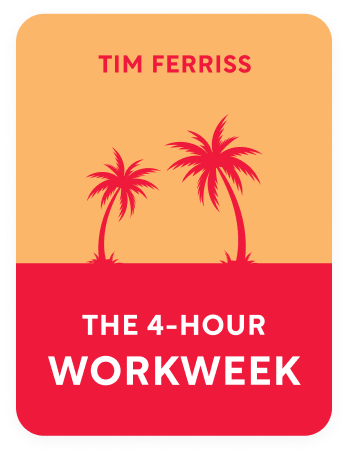

This article is an excerpt from the Shortform book guide to "The 4-Hour Workweek" by Tim Ferriss. Shortform has the world's best summaries and analyses of books you should be reading.
Like this article? Sign up for a free trial here .
Are you looking for The 4-Hour Work Week exercises to help you make the most of the book’s strategies? How can the book help you improve?
These exercises cover all the major concepts in the books, from fear-setting to hiring a virtual assistant. You can use these The 4-Hour Work Week exercises to practice concepts and think critically about how to apply the concepts to your life.
Keep reading for The 4-Hour Work Week exercises to help you achieve your goals.
The 4 Hour Work Week: Exercises
These 31 The 4 Hour Work Week exercises can help you work on strategies in all parts of the book. Use each one to help you learn about different strategies and how they work.
Start to Fear-Set
This first groups of The 4-Hour Work Week exercises are about one of the core principles, fear-setting. Once we articulate and define our fears, they’re less frightening.
Think of something you want to do but are scared to. If you do this thing, what’s the worst possible outcome?
What are the consequences and how permanent are they? How likely is this worst-case scenario?
If the worst-case scenario did happen, how would you recover? Think of ways to fix all the consequences you listed above.
The worst-case scenario is never the most likely scenario. What are some of the other possible scenarios? What are their positive and negative outcomes?
Brainstorm Dreams
The first step of dreamlining is to brainstorm.
What are some things you’ve always wanted to have?
What are some things you’ve always wanted to do?
What are some things you’ve always wanted to be?
What are some specific things that would demonstrate that you’ve become what you want to be? For example, if you want to be strong, you could specifically want to be capable of doing 30 push-ups in a row.
Choose your top four dreams. Write down the first step that you will do to achieve them. You should do this first step today.
Learn Selectively
Step E (Eliminate) of the DEAL process involves learning to ignore any unimportant or unactionable information.
Think of the last time you needed to learn something. For example, perhaps you were trying to decide which kind of credit card to sign up for. How did you learn? How long did it take you?
Now, think of something new you’d like to learn. Who do you know who could give you an overview of the topic? If you don’t personally know anyone knowledgeable in the subject, who could you get in touch with? Consider authors of books on the subject, industry experts, and so on.
How long do you think it would take you to learn using this second method?
Batch Monthly
This next group of The 4-Hour Work Week exercises is about a time management technique, batching. “Batching” involves saving up a bunch of routine tasks to do all at once.
What is a routine task that you have to do every week? You can choose either a personal or professional task.
How much time does it take you to set up each time you do the task above? Multiply this number by four to get the approximate amount of time you spend on set-up per month.
If you did the task only once a month, you would only have to spend the set-up time once instead of four times. How much time would you save if you batched this activity?
Transition to Remote Work
There are two methods for transitioning to remote work: the five-step method and the hourglass method.
What are some logistical problems you might encounter if you transitioned to remote work? Are there parts of your job that would be hard to do remotely?
How important are they? How would you do them remotely if you had to?
How could you make yourself more valuable to your boss and company? Think of an event or training sessions that you could ask to attend.
Which of the two methods do you think would work better for you? Why? Remember that the five-step method involves slowly transitioning to remote work, and the hourglass method involves going fully remote, then pulling back to part-time trial remote, then slowly transitioning back to fully remote.
Delegate to a Virtual Assistant (VA)
You can save yourself a lot of time by hiring a VA to do tasks for you.
What are some specific, time-consuming, remote-friendly tasks that you do in your personal or professional life?
How could you delegate the above tasks to a VA? Think about how you would phrase your instructions.
For the above tasks, what timelines you would give, and what kinds of rules you would set up?
What are some tasks that you really hate doing or that make you uncomfortable?
Could you delegate these uncomfortable tasks to a VA? Think of ways you could make the task specific and remote-friendly. For example, if you hate mowing the lawn because you’re allergic to grass, you could ask your VA to set you up with an affordable landscaping service.
Find Your “Muse”
This group of The 4-Hour Work Week exercises is about having a muse. A “muse” is a self-sustaining business that sells a product.
The first step to finding your muse is coming up with a niche market you could sell a product to. What markets are you a part of? Consider your job and hobbies. How could you narrow these markets to come up with a niche market?
The second step is to brainstorm products you could sell to your market. Since you’re part of your market, what products do you already own? What products do you wish existed? What kind of information product could you create?
The third step is to test your product by advertising and “selling” it. What would you put in an ad for your product? What makes it different from existing products? Would you offer some sort of money-back guarantee?
Apply the 80/20 Rule to Your Belongings
Having a lot of material possessions creates a lot of mental clutter.
Think about the material possessions that you own. What possessions fall into the top 20%? Consider which possessions make you happy, are useful, or allow you to do things you want to. For example, if you love to play the guitar, your guitar would be in your top 20%.
What possessions fall into the bottom 20%? Consider which of your things take up a lot of space or that you never use. For example, if you bought a mouthguard because you wanted to get into rugby and then later discovered you hated rugby, the mouthguard would be in your bottom 20%.
What are the negative consequences of getting rid of anything on your bottom 20% list? Are any of them permanent?
You can uses these The 4-Hour Work Week exercises as you go through the book, or any time you need to go back to refresh on the strategies.

———End of Preview———
Like what you just read? Read the rest of the world's best book summary and analysis of Tim Ferriss's "The 4-Hour Workweek" at Shortform .
Here's what you'll find in our full The 4-Hour Workweek summary :
- The 4-step process to live a "retired" lifestyle now
- Find out if you're wasting the best years of your life working a 9-5
- How to create a business that makes you money without sucking up your time






